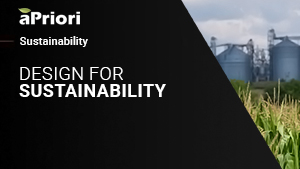Video
Reduce Your Environmental Impact with Design for Sustainability
Did you know that 100% of companies in some sectors have set sustainability goals, but only 40% of them feel like they have the knowledge and capabilities to achieve their targets?
Design for sustainability can be easier than you think.
In this video, the expert team at aPriori shows you how to design products with lower environmental impact, all while keeping your product cost targets at the forefront.
This video is ideal for anyone who wants to learn how to reduce the environmental impact of their product designs.

Transcript
Mark Rushton: Hello and welcome to this presentation on Design for Sustainability, where we’ll be taking a look at a number of different ways in which you can reduce the environmental footprint of your product designs. My name is Mark Rushton. I’m part of the product marketing team at aPriori responsible for our design engineering and sustainability products. Sustainable design is a very broad term and one with many different definitions depending on where you’re coming from. So I’ll spend some time on what it means to us at aPriori. The same is true for the definition of a sustainable product, this will be different for almost everyone , so we’ll touch upon that in this session as well. Then we’ll take a look at the importance of benchmarking. This is critical if you want to avoid being accused of greenwashing, and also if you want to meet sustainable development goals. We will also dive into how you can start to lower the carbon footprint of your products and product manufacturing. Knowing where to start is crucial. Then we’ll look at the impact of materials and manufacturing processes and how they contribute to greenhouse gas emissions. And we’ll finish up with how aPriori can help deliver the decision-making insights you need to go from intent to action towards your sustainability goals. Let’s begin!
Why Should Manufacturers Design Products with Sustainability in Mind?
Why are we even talking about sustainable design today? Well, for one, it’s the right thing to do. The climate is getting hotter and scientists say we’re close to a point of no return. Customers and consumers are demanding more sustainable products, and they are willing to pay more for them. In fact, results from a 2022 survey show that sustainability efforts are being driven by consumer demand, along with net zero goals. Investors are applying pressure. They know that there are several risks with businesses that are not on the right path; therefore, investor funds are much harder to come by unless you have a good sustainability strategy. And lastly, legislators are getting involved. We have seen the EU, the UK (and others) set compliance dates. The SEC in the US has also made proposals for similar environmental sustainability reporting. And we’re seeing results of these pressures transferring into long-term business goals.
Climate Change: Protect Future Generations
Another reason to look at sustainable design is that we’re currently using more resources than the Earth can replenish. In 2022, Earth Overshoot Day (which marks the date when humanity has used all the biological resources that Earth regenerates during the entire year) happened on July 29th. We simply must reduce the amount of environmental resources we all use. The negative impacts are evident. There are many images of glaciers retreating drastically over the past few decades. These images are shocking. Greenhouse gas emissions are growing rapidly along with global average temperatures. We can work together to protect the environment for future generations.
New Product Sustainable Design Approach
Although many companies have defined a sustainable strategy, less than half believe they have the knowledge to get started. This is no surprise as it can be an incredibly complex undertaking. It’s not like product cost, where you can sometimes take an educated guess at which design is cheaper. With carbon reduction efforts, in many cases, the decisions will be massively counter-intuitive. In fact, there are lots of different definitions around sustainability and product design, such as:
- Sustainable design considers the social impact as well as the environmental impact of developing products.
- Eco-design is purely focused on the environmental impact, and it’s really about decreasing footprint as much as possible.
- Circular design and circular economy have to do with reusing materials and resources as often as possible.
How can Manufacturers Create Benchmarks to Optimize Their Sustainable Development Goals?
How do you become a sustainable company producing sustainable products? There are some that believe that there is no such thing as a green product, and that a better approach is to measure the overall green vs. net green impact. To do that, the proper benchmarks need to be identified. The trouble is identifying which benchmarks are the right benchmarks. Consider these examples:
If a consumer is in the market for a new vehicle, would a hybrid SUV be considered the greener option over an ICE (internal combustion engine) SUV? The answer seems simple, right?
But what if this SUV is the consumer’s second car, and they choose it over public transportation? Is this still the greener option? Now the answer isn’t quite as simple, is it?
All products have some environmental impact. Raw materials. Manufacturing processes. Packaging. Supply chain. The list goes on and the decisions regarding benchmarking can feel overwhelming.
An organization called the Greenhouse Gas Protocol sets the standards to measure and manage emissions. This accounting standard is a good way to benchmark where the emissions are that you need to be aware of in order to control them.
Implementing Eco-Design Methodologies into The Design Process
Luckily, aPriori is particularly good at helping manufacturing teams to make these decisions. Design holds the keys to the majority of a products’ environmental impact. Like cost, 80% of a product’s environmental impact is decided at the design phase. aPriori can even compare and contrast your new product development designs with previous designs or iterations.
Today, many manufacturers are using LCAs (lifecycle assessment tools) to assess a product’s environmental impact. The trouble with this method is that LCAs typically measure AFTER the product is manufactured. These tools do not help design engineers with decisions unless it’s a completely new generation of the product.
What if your design engineers could make minimal design changes to material or manufacturing processes to reduce the CO2 early in the design stage?
Manufacturing and Resource Efficiency
Each design and manufacturing decision has major potential environmental impacts. Imagine if your design engineers had the insights to understand the impacts of where their design will be manufactured. For example, they could consider how the electricity is generated in a particular region. Manufacturing in a region that uses significant renewable energy will have a positive environmental impact on their product design over a region that uses a lot of coal or carbon heavy electricity generation. aPriori can informs design engineers of these types of considerations as they design.
Manufacturing Efficiency Case Study
aPriori’s data partner, ecoinvent, provides data to users that shares the amount of carbon CO2 equivalent emissions for manufacturing processes such as electricity generation in a certain region. In one recent example, a design engineer was able to see that Quebec, Canada and Norway use a lot of renewables to generate electricity, therefore manufacturing their product there would result in very low CO2 equivalent emissions. South Africa, China, and Australia were shown in this example to use a lot more carbon heavy methods for generating electricity. aPriori was vital for this design engineer to determine where to manufacture the product in order to impact carbon emissions in a positive way.
Materials Utilization and Sustainable Development Goals
Material utilization plays a massive role in manufacturing process benchmarks and corporate sustainable development goals.
Material Considerations for sustainability:
- Is it a recyclable material?
- Do we need secondary materials?
- Durability?
- Performance?
- Density (will that create a heavier or a lighter product?)
- How much water is used in the production of that material?
- Cost?
Because of the complexity of the number of variables, you may need to do a trade-off analysis to decide which compromises can be made in order to get the best balance between environmental impact and profitability. Starting with design offers the most holistic approach to building the most sustainable product possible.
aPriori provides instant feedback, so you can consider all variables and get instant feedback to make the best decisions based on sustainability, profitability, and time to market.
Manufacturing Processes and Sustainable Development Goals
When it comes to manufacturing processes and sustainable development goals, you really want to focus on material utilization, process time, and manufacturing location. This can be a real balancing act. Here’s why:
Consider product performance. Product performance relies heavily on the product shape, which goes hand-in-hand with material choice. Both of these factors influence the manufacturing process, but the manufacturing process also influences what you can do with shape and material for manufacturability. As you can see, all factors play off one another. Getting fast and reliable feedback is crucial when you’re making decisions.
We must also consider manufacturing location. Manufacturing process choices may limit location options. But if we choose location first, we may limit manufacturing processes, shapes, and materials. And all of these decisions impact cost and sustainability.
Introducing aPriori Sustainability Insights
So how exactly can aPriori help your company reduce its environmental impact with design for sustainability insights?
aPriori’s Sustainability Insights featured in our aP Pro, aP Design, and aP Analytics products empowers your product teams with the data they need to ensure profitability and sustainability without negatively impacting productivity. With Sustainability Insights, your team will be able to identify low cost and low carbon suppliers based on their location. It can evaluate the carbon emissions of alternate design specifications and different materials, which is going to allow us to iterate more, try alternate designs and different materials. You can also try different manufacturing processes to see the effects on greenhouse gases. And the design, the material manufacturing process and local electricity mix generation can all be evaluated together with full visibility into cost and ensuring manufacturability, allowing you to deliver best in-class products on time.
The data your team needs is at their fingertips with aPriori. Taking a holistic approach is how you are going to make the biggest strides forward. aPriori wants to help you by integrating the data driven insights into your existing workflows to allow you to iterate more and reach your sustainability goals.

